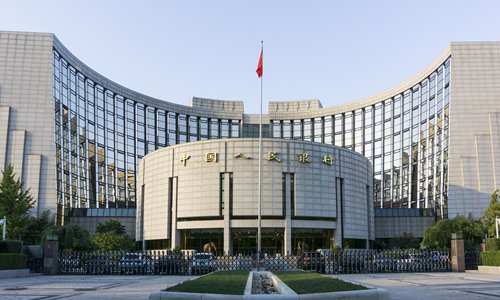April new yuan loans stronger than expected as support continues for virus-ravaged economy
By Li Qiaoyi Source:Global Times Published: 2020/5/11 20:29:42

The headquarters of the People's Bank of China in Beijing Photo: IC
China's new yuan-denominated loans were stronger than expected in April, central bank data showed Monday, as the nation maintains monetary support for its coronavirus-ravaged economy.
The continued financial buoyancy presages a revival of the economy, which is likely to start growing again during the current quarter, according to market observers.
New yuan lending hit 1.7 trillion yuan ($240.28 billion) in April, according to data from the People's Bank of China (PBC), beating market estimates of about 1.4 trillion yuan.
The April reading pulled back from the previous month's 2.85 trillion yuan, but it was still substantially higher than the 1.02 trillion yuan extended in April 2019.
Total social financing fell from a record high of 5.15 trillion yuan in March, but still beat estimates to reach 2.98 trillion yuan in April, according to the Global Times' calculation based on PBC statistics.
Broad M2 money supply growth edged up to 11.1 percent year-on-year in April from 10.1 percent in March, while M1 narrow money supply climbed to 5.5 percent from 5 percent in the prior month.
The April data showed a conspicuous improvement in credit on a yearly basis, factoring in the usual slack at the start of each quarter as banks prepare for regulatory assessments, Lian Ping, head of Zhixin Investment Research Institute, told the Global Times on Monday.
The buoyancy of new lending, social financing and growth in both M2 and M1 suggests an apparent uptick in the real economy on the demand side, Lian said.
The economy is well on track for a rebound, he believes, forecasting GDP growth to return to positive territory in the second quarter, probably in the range of 2-4 percent, a marked revival from a contraction of 6.8 percent in the first three months.
Domestic demand is "expected to recover somewhat in April amid a stabilizing pandemic situation," DBS economists Taimur Baig and Nathan Chow said in a note sent to the Global Times on Monday.
"Workers returned to factories and offices as depicted by the improving energy consumption and traffic data," the economists said, expecting an improvement in both retail sales and industrial production.
Looking ahead, lending rates are likely to keep falling to support the virus-hit economy, market watchers said.
Both the benchmark loan prime rate (LPR) and the interest rate on medium-term lending facility loans would continue to trend lower, Lian predicted, noting that the adoption of the LPR as a benchmark for pricing outstanding floating-rate loans this year is set to further lower funding costs.
New lending accounts for about one-third of all credit while outstanding loans represent the rest, according to Lian. Financial support tailored for smaller businesses is also expected to continue, he added.
The PBC has ramped up support for micro-sized, small, and medium-sized enterprises this year in light of the epidemic. The central bank has already announced 300 billion yuan in special relending, 500 billion yuan in relending, an injection of 550 billion yuan through targeted reserve requirement cuts, and a temporary extension of principal and interest repayments, among other arrangements, Chen Yulu, a deputy governor of the PBC, told a media briefing over the weekend.